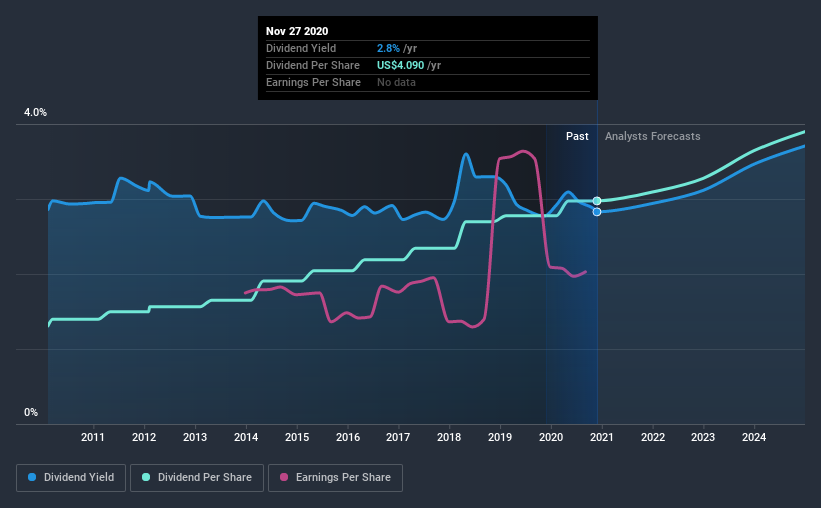Just Four Days Till PepsiCo, Inc. (NASDAQ:PEP) Will Be Trading Ex-Dividend
Readers hoping to buy PepsiCo, Inc. (NASDAQ:PEP) for its dividend will need to make their move shortly, as the stock is about to trade ex-dividend. You can purchase shares before the 3rd of December in order to receive the dividend, which the company will pay on the 7th of January.
PepsiCo's next dividend payment will be US$1.02 per share, on the back of last year when the company paid a total of US$4.09 to shareholders. Based on the last year's worth of payments, PepsiCo stock has a trailing yield of around 2.8% on the current share price of $144.6. Dividends are an important source of income to many shareholders, but the health of the business is crucial to maintaining those dividends. We need to see whether the dividend is covered by earnings and if it's growing.
View our latest analysis for PepsiCo
Dividends are typically paid out of company income, so if a company pays out more than it earned, its dividend is usually at a higher risk of being cut. Its dividend payout ratio is 78% of profit, which means the company is paying out a majority of its earnings. The relatively limited profit reinvestment could slow the rate of future earnings growth. It could become a concern if earnings started to decline. Yet cash flow is typically more important than profit for assessing dividend sustainability, so we should always check if the company generated enough cash to afford its dividend. Over the last year, it paid out more than three-quarters (85%) of its free cash flow generated, which is fairly high and may be starting to limit reinvestment in the business.
It's positive to see that PepsiCo's dividend is covered by both profits and cash flow, since this is generally a sign that the dividend is sustainable, and a lower payout ratio usually suggests a greater margin of safety before the dividend gets cut.
Click here to see the company's payout ratio, plus analyst estimates of its future dividends.
Have Earnings And Dividends Been Growing?
Stocks in companies that generate sustainable earnings growth often make the best dividend prospects, as it is easier to lift the dividend when earnings are rising. If earnings decline and the company is forced to cut its dividend, investors could watch the value of their investment go up in smoke. With that in mind, we're encouraged by the steady growth at PepsiCo, with earnings per share up 3.3% on average over the last five years. A high payout ratio of 78% generally happens when a company can't find better uses for the cash. Combined with slim earnings growth in the past few years, PepsiCo could be signalling that its future growth prospects are thin.
Another key way to measure a company's dividend prospects is by measuring its historical rate of dividend growth. Since the start of our data, 10 years ago, PepsiCo has lifted its dividend by approximately 8.6% a year on average. It's encouraging to see the company lifting dividends while earnings are growing, suggesting at least some corporate interest in rewarding shareholders.
Final Takeaway
Is PepsiCo worth buying for its dividend? Earnings per share growth has been unremarkable, and while the company is paying out a majority of its earnings and cash flow in the form of dividends, the dividend payments don't appear excessive. Overall we're not hugely bearish on the stock, but there are likely better dividend investments out there.
If you're not too concerned about PepsiCo's ability to pay dividends, you should still be mindful of some of the other risks that this business faces. Our analysis shows 3 warning signs for PepsiCo and you should be aware of these before buying any shares.
If you're in the market for dividend stocks, we recommend checking our list of top dividend stocks with a greater than 2% yield and an upcoming dividend.
This article by Simply Wall St is general in nature. It does not constitute a recommendation to buy or sell any stock, and does not take account of your objectives, or your financial situation. We aim to bring you long-term focused analysis driven by fundamental data. Note that our analysis may not factor in the latest price-sensitive company announcements or qualitative material. Simply Wall St has no position in any stocks mentioned.
Have feedback on this article? Concerned about the content? Get in touch with us directly. Alternatively, email editorial-team@simplywallst.com.

 Yahoo Finance
Yahoo Finance 
